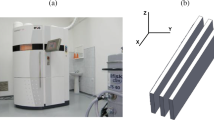Abstract
It’s important to measure quantitative properties about the thermal-nano behavior of polymers in order to produce high quality components using the nanoimprint lithography process. Nanoscale indentation can be used to make the cells for molecular electronics, drug delivery, slots for integration into nanodevices and defects for tailoring both the structure and properties. In this study, the formability of polymethylmetacrylate (PMMA) and polycarbonate (PC) were characterized. Thermo-mechanical properties during formation at a high temperature. Polymers become softer at elevated temperature due to heating. In this case it is particularly important to study the high temperature-induced mechanical properties of the polymer. Nanoindentation was used to measure the thermo-mechanical properties of both PMMA and PC. The polymer was heated with the heating stage on a NanoXP. For a CSM (Continuous Stiffness Method) mode test, the heating temperature was 110°C, 120°C, 130°C, 140°C and 150°C for the PMMA, and 140°C, 150°C, 160°C, 170°C and 180°C for the PC. The maximum indentation depth for this test was 2000 nm. For the basic mode test, the heating temperature was 90°C and 110°C for the PMMA, and 140°C and 160°C for the PC. The maximum loads for this test were 10 mN, 20 mN and 40 mN. An indented pattern was also observed by using AFM. The pile-up phenomenon was mitigated due to the indentation at elevated temperature but the sink-in phenomenon occurred in this instance. When patterning at a high temperature, one should consider the variation in the indentation profile and depth after unloading when designing a structure. It was thought that the mechanical properties decrease when the working temperature increases because PMMA and PC are thermoplastics which soften or melt by heating. Further research in this area is required about the molecular weight and molecular movement at elevated temperature when the free volume of molecules increases.
Similar content being viewed by others
References
Hardt, D., Ganesan, B., Oi, W., Dirckx, M. and Rzepniewski, A., “Process Control in Micro-Embossing: A Review,” Singapore MIT Alliance Programme (SMA) in Innovation in Manufacturing Systems and Technology (IMST), 2004.
Choi, C. G., “Fabrication of optical waveguides in thermosetting polymers using hot embossing,” J. Micromech. Microeng., Vol. 14, No. 7, pp. 945–949, 2004.
Kim, W. S., Yoon, K. B. and Bae, B. S., “Nanopatterning of photonic crystals with a photocurable silica-titania organic-inorganic hybrid material by a UV-based nanoimprint technique,” J. Mater. Chem., Vol. 15, No. 42, pp. 4535–4539, 2005.
Ishihara, K., Fujita, M., Matusubara, I., Asano, T. and Noda, S., “Direct Fabrication of Photonic Crystal on Glass Substrate by Nanoimprint Lithography,” Japanese Journal of Applied Physics Part 2, Vol. 45, No. 4–7, pp. L210–L212, 2006.
Heidari, B., Maximov, I. and Montelius, L., “Nanoimprint lithography at the 6 in. wafer scale,” J. Vac. Sci. Technol. B, Vol. 18, No. 6, pp. 3557–3560, 2000.
Cameron, N. S., Roberge, H., Veres, T., Jakeway, S. C. and Crabtree, H. J., “High fidelity, high yield production of microfluidic devices by hot embossing lithography: rheology and stiction,” Lab Chip, Vol. 6, No. 7, pp. 936–941, 2006.
Li, X. and Bhushan, B., “Fatigue studies of nanoscale structures for MEMS/NEMS applications using nanoindentation techniques,” Surface and Coatings Technology, Vol. 163–164, pp. 521–526, 2003.
O’Connell, B. S., Cross, G. L. W., Pethica, J. B. and Oliver, W., “Nanorheology of squeezed polymer films,” Proc. Third IEEE Conference on Nanotechnology, Vol. 2, pp. 793–796, 2003.
Guo, L. J., “Recent progress in nanoimprint technology and its applications,” J. Phys. D: Appl. Phys., Vol. 37, No. 11, pp. 123–141, 2004.
Scheer, H. C. and Schulz, H., “A contribution to the flow behaviour of thin polymer films during hot embossing lithography,” Microelectronic Eng., Vol. 56, No. 3–4, pp. 311–332, 2001.
Yao, D. and Virupaksha, V. L., “Study on Squeezing Flow During Nonisothermal Embossing of Polymer Microstructures,” Polymer Eng. and Sci., Vol. 45, No. 5, pp. 652–660, 2005.
Park, J. W., Lee, D. W., Kawasegi, N. and Morita, N., “Nanoscale Fabrication in Aqueous Solution using Tribo-Nanolithography,” Int. J. Precis. Eng. Manuf., Vol. 7, No. 4, pp. 8–13, 2006.
Kang, H. J., Ahn, S. H., Lee, J. S. and Lee, J. H., “Surface Modification of Aluminum by Nitrogen-Ion Implantation,” Int. J. Precis. Eng. Manuf., Vol. 7, No. 1, pp. 57–61, 2006.
Fischer-Cripps, A. C., “Nanoindentation,” Springer-Verlag New York, pp. 74–76, 2002.
Stevens, M. P., “Polymerchemistry: 3rd Edition,” Oxford University Press, pp. 100–106, 1999.
Author information
Authors and Affiliations
Corresponding author
Rights and permissions
About this article
Cite this article
Lee, EK., Kang, CG. & Lee, SM. Evaluation of mechanical characteristics of the plate-type polymer hyperfine pit pattern by the nanoindentation process. Int. J. Precis. Eng. Manuf. 11, 461–468 (2010). https://doi.org/10.1007/s12541-010-0053-9
Received:
Accepted:
Published:
Issue Date:
DOI: https://doi.org/10.1007/s12541-010-0053-9



